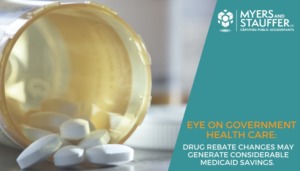 In a series of posts, Myers and Stauffer will highlight parts of the American Rescue Plan Act of 2021[1] that can have tremendous impact on delivery and financing of services by state health and human services programs.
In a series of posts, Myers and Stauffer will highlight parts of the American Rescue Plan Act of 2021[1] that can have tremendous impact on delivery and financing of services by state health and human services programs.
The next installment of our series on the American Rescue Plan Act (ARPA) of 2021 focuses on the changes to the Medicaid Drug Rebate Program (MDRP), which require drug manufacturers to provide certain rebates to state Medicaid programs in order to have their drugs covered by Medicaid.
Rebate amounts are determined by three federal rebate requirements: (1) a base amount calculated as a percentage of the average manufacturer price (AMP) (i.e., 23.1% for most brand-name drugs and 13% for generic drugs); (2) a “best price” adjustment or offset that ensures Medicaid programs receive the lowest price available from the manufacturer during the rebate period; and (3) an additional inflationary rebate for brand-name and generic drugs if the increase in a drug’s AMP rises faster than general inflation. The latter is specifically designed to discourage manufacturers from implementing excessive price increases; however, under current law, total Medicaid drug rebates for these drugs cannot exceed 100% of the AMP. In effect, this federal “rebate cap” currently allows manufacturers that implement large price increases over time to avoid paying rebates equal to the full difference between the price increase and inflation. Once the rebate cap is reached, there is less incentive to moderate drug price increases since further price increases do not result in larger rebates to Medicaid programs.
With passage of the ARPA, beginning in 2024, the rebate cap will be eliminated, thereby creating further incentives for manufacturers to limit price increases by enabling state Medicaid agencies to collect more rebates when such increases occur. Estimates from the Congressional Budget Office suggest that elimination of the rebate cap will result in a $15.9 billion reduction in net state and federal Medicaid spending over the next ten years, thereby decreasing the amount of state general funds necessary to meet federal matching requirements and freeing up state funding for other needed services or to help address budget deficits.[1] Elimination of the rebate cap may also have other indirect impacts that states may wish to consider:
- Rebates for brand drugs whose prices have been, or will be, consistently raised and have reached the 100% rebate cap will likely increase.
- Since supplemental rebates are often negotiated as a guaranteed net price after all rebates, increases in MDRP rebates may reduce supplemental rebates, minimizing the net impact to states. Potentially, this may create new opportunities to engage manufactures regarding supplemental rebates
- To the extent that elimination of the rebate cap changes overall net after rebate prices, states may see opportunities to re-evaluate preferred drug lists.
- States could see manufacturers leave the Medicaid market; however, this is unlikely and the degree to which this would occur is uncertain, as it would require removal of all of the manufacturer’s covered drugs from the program, not just those that exceed the rebate cap.
- States may see a shift in overall manufacturer engagement/pricing strategies, which may require additional state monitoring, planning, and policy responses.
- States may see higher launch prices moving forward as manufacturers seek to mitigate future price increases that exceed inflation benchmarks.
- It is unclear whether any increases in rebate amounts will accrue to state Medicaid agencies or whether they will be retained by the federal government.
If you have questions about this or any other portion of the American Rescue Plan, please contact us.
[1] https://www.cbo.gov/publication/57002
Contact the Contributors:
| Allan Hansen Principal ahansen@mslc.com |
Bobby Courtney, MPH, JD Principal bcourtney@mslc.com |



